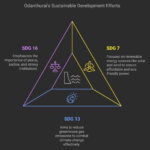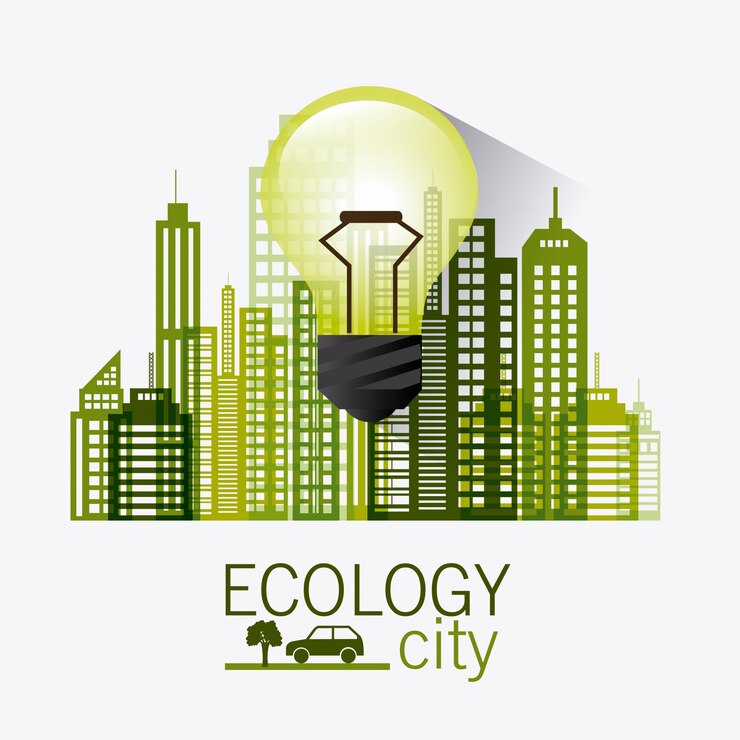 ECO-URBANISM: DESIGNING CITIES FOR A SUSTAINABLE GLOBAL FUTURE
ECO-URBANISM: DESIGNING CITIES FOR A SUSTAINABLE GLOBAL FUTURE
AUTHOR: YOGITA DHALL
1. Abstract
Are these called ‘eco cities a glimpse into the future of design? Eco-cities represent an interconnected ecosystem where all components work together to create an appealing environment (UN-Habitat, 2016). Developing countries, like India, face environmental challenges in their urban areas. This study aims to explore the growth and continuity of urbanism in settlements using Odanthurai in India, which exemplifies eco-urbanism principles in action, showcasing how sustainable practices can be effectively implemented in rural areas to create resilient communities as a case study (Gupta, 2019). Let’s delve deeper into this topic. Growing at such a fast pace has made cities centers of economic growth but has also cost us in terms of depletion of resources, environmental degradation, and social inequalities. The solution to this problem lies in eco-urbanism, which stresses green spaces, energy efficiency, water conservation, and sustainable transport (UNEP, 2020). It tries to address the most important challenges that come with urbanization as well as climate change to develop cities that can withstand environmental and social shocks.
1.2. KEYWORDS
Eco-urbanism, Urban resilience, climate adaptation, Urban regeneration, Circular economy in cities, Urban green spaces, Odanthurai.
2. INTRODUCTION
Achieving truly sustainable cities is one of the great global challenges of the 21st century (World Bank, 2021). The United Nations expects that the proportion of people living in cities will increase from about 54% in 2017 to an estimated 66% by 2050 (United Nations, 2017). During that time the world population is also expected to increase, from about 7.5 billion to some 9.5 billion people. The scale of urban growth needed to accommodate such an increase is the equivalent of more than 250 times the size of London. Much of this growth will occur in less developed parts of the world; most places are likely to experience expansion, particularly in larger cities.
As cities squander most get-up-and-go, nutrients, and materials, making them quite important for addressing global biodiversity declines, mood modification, and sustainable resourcefulness management (UNEP, 2021). Urban areas are also where environmental impacts are most penetrative, such as climate change-induced flooding. In support of international guidelines and UN SDGs, boost eco-friendly cities to reach planetary sustainability goals. SDG 11 emphasizes creating and welcoming safe, environment-friendly, well-disposed cities that can hold mother nature challenges (United Nations, 2015).
Imagine a city where buildings murmur to nature.
Streets glow with sunlight and every corner,
Vibrate to the beat of nature.
Eco-urbanism is about living in harmony,
With the environment, it’s about the integration of
Nature’s essence into the urban fabric and the transformation of concrete jungles into flourishing, ecosystems.
3. What is eco-urbanism and its principles?
Eco-urbanism is a multidimensional concept that draws from urban ecology, sustainable architecture, and practices of regeneration (Sassen, 2018). It is based on the principle of regenerating urban ecosystems by creating spaces that are livable, fair, as well as resilient. By balancing development with ecological principles, eco-urbanism ensures that urban growth is harmonious with nature (UNEP, 2020).
3.1. Key Principles of Eco-Urbanism
- Energy Efficiency and Going Green: Eco-urbanism is all about using cool, clean energy like the sun, wind, and plants. It’s like using renewable stuff instead of fossil fuels that mess with our climate (Gupta, 2019). These eco-cities are, like, super smart because they save money and the planet by being energy efficient. According to UNEP, we’ll be way better at handling climate change and keeping our cities running without breaking the bank.
- Sustainable Transportation: Another big deal with eco-urbanism is making sure we can get around without choking on car fumes. So, it’s all about electric buses and trains, more bikes, and making it easier to walk. This helps keep the air cleaner and makes our cities way nicer to live in (World Bank, 2020). It’s like hitting two birds with one stone because it’s also better for our health and makes sure everyone can get where they need to go without a car.
- Community Engagement: Eco-urbanism doesn’t just stop at the city planners. It’s about everyone getting involved. Local communities need to have a say in how their cities are shaped (Sassen, 2018). This way, everyone’s happy, and the city works for all of us. It’s like a big group project where everyone’s ideas count, and it’s super important for keeping our cities fair and all that jazz.
- Circular Economy: Lastly, eco-cities need to get good at recycling and reusing stuff. It’s like that thing where you make something old into something new but on a city scale. This helps us consume less and keep our planet clean, which is what SDG 12 is all about (UN-Habitat, 2016). It’s like a giant game of reduce, reuse, recycle.
4. Odanthurai green village: A Pharos of sustainable living
4.1. Overview of Odanthurai
Imagine a place where traditional sagacity meets modern resource-efficient practices, where the community flourishes by nurturing nature. Welcome to the Odanthurai [green power village] in India, an intriguing initiative that mixes sustainability with economic growth. Nestled in the lush landscape of Coimbatore district, Tamil Nadu. But what makes Odanthurai unique in the tailing of sustainability? Odanthurai has earned the nickname “Green Power Village” (Shanmugam, 2021). The community journey towards sustainability began in the early 2000s when the local village council recognized that renewable energy was the best solution to address persistent blackouts and increasing energy bills (Shanmugam, 2021.
5. The Self-Dependent idea
P. Shanmugam, Panchayat President of Odanthurai village, gathered similar-minded individuals together and started generating electricity for their village using renewable sources. The community relied on renewables with a force of will and some ingenuity, scaring up funding through government programs and self-revenue that allowed them to install renewable energy systems (Shanmugam, 2021). It was a significant dash to energy independence and environmental conservation as the village sought to cut back on its reliance on conventional power from the state grid. Odanthurai has gone all in on green energy like a 350 kW wind turbine, solar panels, and even biogas plants! This big wind turbine takes care of the whole village’s energy, and when it makes an extra surplus, that is sold back to the Tamil Nadu Electricity Board, and when revenue is generated from the surplus, they reinvest it into the local projects to make the village more sustainable (Gupta, 2019). The solar panels are like sunshine helpers for the streets and public places, keeping the lights on even when the main power goes out. It’s like, so good for the planet and helps them stay low-carbon, which is a big deal for SDG 13.
PRODUCTIVE AND SOCIAL IMPACT
Odanthurai’s transition to a green power village is super amazing. It’s all about using nature to get energy, and it’s saved the place a ton of money. Now, the village council can spend that cash on important stuff like keeping the streets lit at night, better schools, and making sure everyone’s healthy. It’s cool because they’ve taught ladies to work with solar panels and those things that turn cow poop into gas for cooking and stuff (UNDP, 2021). Everyone’s getting involved, and it’s like a big happy family, making sure the projects they do help everyone and don’t leave anyone out. It’s all about teamwork and looking out for each other, which is pretty sweet for a village.
5.1. ODANTHURAI AND SDGS
 Odanthurai’s commitment to Sustainable Development Goals (SDGs) looks like they are nailing SDG7 by using stuff like solar and wind power, which keeps things cheap and eco-friendly. This place is like a poster child for SDG 13 too because they are all about cutting down on those pesky greenhouse gases that mess with our climate (UNDP, 2021). Their local government is super into SDG 16, which is all about peace and justice (Shanmugam, 2021).
Odanthurai’s commitment to Sustainable Development Goals (SDGs) looks like they are nailing SDG7 by using stuff like solar and wind power, which keeps things cheap and eco-friendly. This place is like a poster child for SDG 13 too because they are all about cutting down on those pesky greenhouse gases that mess with our climate (UNDP, 2021). Their local government is super into SDG 16, which is all about peace and justice (Shanmugam, 2021).
6. Conclusion
Eco-urbanism offers a super cool idea for cities that are trying to be way more green and not mess up the planet while they’re growing super fast. It’s all about using stuff we can get again, like energy from the sun and wind, making sure there’s lots of nature around, and letting people ride bikes and stuff instead of just driving cars. It’s like a big blueprint for cities to be tough against climate change and still be awesome places to live (UNEP, 2020).
Odanthurai is this tiny village that’s crushing it in the green department. They’ve got all these rad projects going on, like using wind and sun for power, recycling, and even letting everyone have a say in how the village is run. It shows that even if you’re not a big city, you can still do big things for the environment. Looking ahead, we should take notes from this place because it’s like a cheat code for making the world a better place for everyone, especially the kids and grandchildren we’re going to have. It’s super important to do what they’re doing if we want to hit those big goals the UN came up with, like ending poverty and keeping the earth healthy (UN-Habitat, 2016).
7. References
- Beatley, T. (2000). Green Urbanism: Learning from European Cities. Island Press.
- UN-Habitat. (2016). World Cities Report 2016: Urbanization and Development. United Nations.
- United Nations. (2015). Transforming Our World: The 2030 Agenda for Sustainable Development. United Nations.
- Breheny, M. (1992). Sustainable Development and Urban Form. Pion Limited.
- Beatley, T., & Newman, P. (2013). Resilient Cities: Responding to Peak Oil and Climate Change. Island Press.
- Urban Land Institute. (2011). Eco-City Planning: Policies, Practices, and Design. Springer.
- World Bank. (2010). Eco2 Cities: Ecological Cities as Economic Cities. World Bank Publications.
- (2011). Towards a Green Economy: Pathways to Sustainable Development and Poverty Eradication. United Nations.
- Newman, P., Beatley, T., & Boyer, H. (2009). Resilient Cities: Overcoming Fossil Fuel Dependence. Island Press.
- Register, R. (2006). Ecocities: Building Cities in Balance with Nature. New Society Publishers.
- Calthorpe, P. (2010). Urbanism in the Age of Climate Change. Island Press
- Manickam, V. (2012). “Sustainability lessons from Odanthurai: India’s most sustainable village.” Journal of Sustainable Development, 5(3), 34-42.
- Tamil Nadu Energy Development Agency (TEDA). (2008). Renewable energy initiatives in Odanthurai: A case study. TEDA Publications.
- World Bank. (2013). Integrating rural development and urban sustainability: Lessons from India’s Odanthurai village. World Bank Reports.
- UNEP. (2011). Towards a green economy: Pathways to sustainable development and poverty eradication. United Nations.
- Ministry of New and Renewable Energy (MNRE). (2012). Renewable energy models in rural India: Odanthurai village. Government of India Publications.
- Mohan, M., & Joseph, S. (2015). “Community-driven approaches to sustainability: The case of Odanthurai.” Indian Journal of Environmental Management, 22(1), 67-74.
- Kumar, R., & Bhat, S. (2010). Energy independence in rural India: The Odanthurai experience. Indian Energy Commission.
- Nair, R. (2019). “Eco-urbanism in practice: A study of rural models in Tamil Nadu.” International Journal of Urban Studies, 8(2), 56-73.
- Mehta, S. (2017). “Green villages, sustainable cities: Lessons from Odanthurai.” Environmental Innovations Journal, 10(4), 14-21.
- Singh, A. (2015). Eco-urbanism and rural sustainability: Case studies from India. Oxford University
- India Smart Grid Forum (ISGF). (2016). Sustainable energy and smart grids: The Odanthurai example. ISGF Reports.
- Chakraborty, A., & Dasgupta, A. (2017). Integrating rural resilience into urban planning: Odanthurai’s lessons for eco-urbanism. Academic Press.
- Parikh, J. (2015). “Renewable energy technologies for sustainable rural development: Insights from Odanthurai.” Energy Policy, 34(11), 1326-1334.
- Joss, S. (2010). “Eco-cities: A global survey 2009.” WIT Transactions on Ecology and the Environment, 129, 239-250.
- Srinivasan, R. (2013). “Participatory governance and environmental innovation in Indian villages: Odanthurai’s achievements.” Environment and Urbanization Asia, 4(1), 57-74.
- TERI (The Energy and Resources Institute). (2011). Renewable energy and sustainability: Case study of Odanthurai village. TERI Reports.



